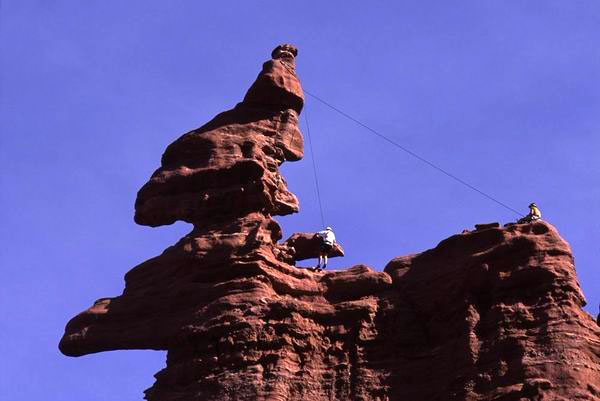
Rockin’ in Moab
By
Phil Maranda
“What the hell am I doing up here?” I want to shout
across the desert. The truth be known, it was my bright idea in the first
place. A simple request I’d made on the phone two weeks earlier
echoes in my mind: “I’d like to take a basic rock climbing
course on my first day and then climb a tower the next.” Now I’m
stuck under a ledge, 150 feet above the ground on a massive tower called
Ancient Art, most of my knuckles white from the strain of hanging on,
others bleeding from smashing my hands on the rock. Sweat pours into my
eyes, my muscles burn, my nerves are shot, and for the life of me, I can’t
figure out how to get around and over the protruding slab of red rock.
-Space-
At first blush the desert drew me in. Its towering pillars, chiselled
canyon walls, and arid climate tantalized my senses as the old Toyota
pick-up bumped and rocked along a winding dirt road up Kane Creek Canyon,
only minutes from the town of Moab. It was there in the heart of Utah’s
red-rock country that I would get my initial taste of free climbing on
rock.
Pulling up to the base of a multi-hued, sandstone cliff face not yet touched
by the early morning sun, my guide, Noah Bigwood, hopped out of the truck
and instructed me to grab my gear. We then began our hike up to a rock
climbing area aptly named Ice Cream Parlor for what I thought must have
been the smooth blend of different hues of reds and oranges in the stone.
Shortly after Bigwood and I scrambled around red boulders, sage bushes,
and pastel green scrub brush and grasses in an ancient landscape so foreign
to me that I might as well have been on the moon, we arrived at our destination.
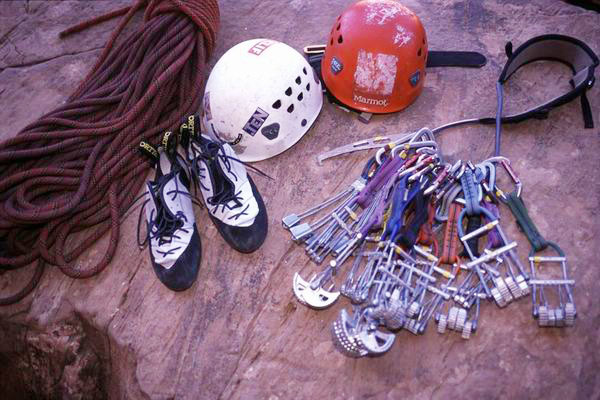
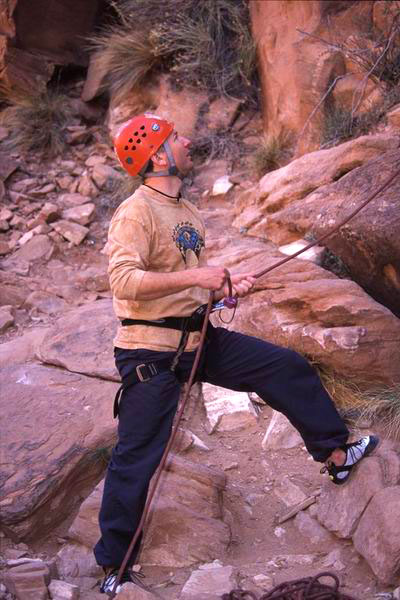
As I eyeballed the polished-looking rock face I’d soon be hanging
on for dear life, Bigwood unpacked the climbing gear and began his pre-climb
instruction. First he mentioned the importance of trusting the equipment,
and then he covered belaying, belay devices, knots, harnesses, locking
carabineers, and his two rock climbing rules—basically all I’d
need to know to get my feet off the ground.
“I have two main rules about rock climbing,” Bigwood said
just before we put on our harnesses and grabbed our gear. “The first
one is that the only reason we do this is because it’s fun. The
second rule, and this relates directly back to the first, is we have to
be safe. If we’re not being safe, it won’t be fun for very
long.”

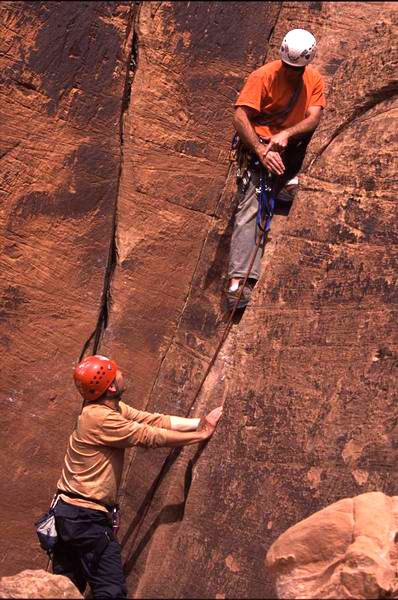
At the wall, it was time to put the theory into practice. Bigwood was
climbing first (lead climbing), and it would be my job to belay him from
the ground. After showing me how he threaded one end of the rope through
his harness and how to tie a doubled up figure-eight knot, he tied another
knot at the end of the rope just beyond the first. “This little
knot can save your life,” he said. “I’ve had two friends
fall because they didn’t tie this knot. If the main knot releases,
this one will stop the rope from sliding right through your harness.”
Bigwood helped me to attach a belay device to my harness by threading
the rope through the device and then locking down the carabineer, an oval-shaped
affair with an opening gate on one side. We then checked and re-checked
our rigs before moving up to the first climb, a 95-foot, ultra-thin crack
in the wall. He motioned for me to stand in a
position where I could hold a fall if I had to and then showed me how
to lock the rope to my hip if an accident did occur. Bigwood gave me the
signal, and I shouted out the commands he had taught me. “You’re
on belay,” I said. “Climbing!” he shouted back from
two feet away. “Climb on,” I replied, and he was gone.


During his climb, my guide placed protection in the form of camming devices
along the crack and called down the different climbing techniques he was
using. Reaching the top, he placed the rope in two bolted metal loops
and informed me he was coming down. Bigwood leaned back into the harness
so his body was at a 45-degree angle to the wall, then walked backwards
while I slowly let the rope slide through the belaying device.
The trick in the rock climbing game is to find an experienced instructor/guide
who’s willing to spend a sufficient amount of quality time with
a rookie. Beginners should become familiar with the equipment and safety
practices in order to feel at ease in the vertical environment associated
with climbing on rock. Bigwood believes that because we spend most of
our lives walking on the ground and even though we do have a history with
the primates of going up, it’s not always as instinctive as it should
be to make the transition from walking to climbing.
Once Bigwood was back on terra firma, we switched roles. He removed the
rope from his harness and attached the belaying device. Under his watchful
eye and further instruction, I threaded the rope through my harness and
then tied my own doubled up figure-eight knot with added safety knot at
the end.
As I moved up to the wall, an ancient fear gripped my body like a vice
and sent butterflies directly to my stomach. To stifle the apprehension,
I took a few deep breaths
and got on with the climb. If I take too long to think about it, I might
jam out right here! I thought to myself.
The first eight feet were surprisingly easy. The crack was wide, there
were lots of handholds to grab onto, and foot placements were readily
available. But when the rift narrowed, the climb changed dramatically.
Suddenly I couldn’t find any handholds, and my feet began to slip
down the slick surface of the rock. Bigwood noticed my predicament and
shouted at me to keep my heels facing downward, allowing as much of the
bottom surface of the shoes as possible to be in contact with the wall.
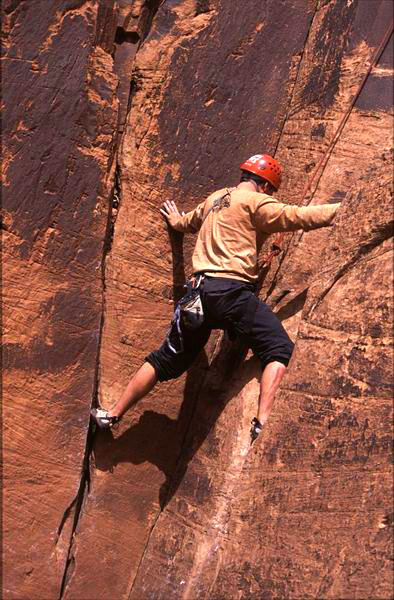
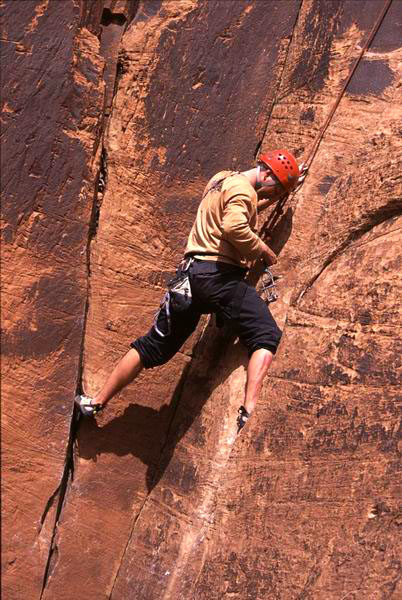
Next, Bigwood instructed me to kick my toes into the crack, again keeping
my heels down, and trust in the extremely sticky, rubber soles of the
rock-climbing shoes. Once I did that, I felt like an insect stuck to fly
paper, and I found it much easier to climb. The wall instantly seemed
to transform; the crack itself made for excellent handholds, and I was
soon feeling like a pro.
By the time I reached the bolted metal loops that held my lifeline in
place, my breathing, which had been short and frantic during my mishap
on the wall, was back to normal. The butterflies in my stomach had miraculously
vanished into thin air, and I could bask in the satisfaction of making
the climb. Bigwood encouraged me to hang around on the rope awhile, and
I did just that before he belayed me back to flat ground.
After a brief rest—mostly for my feet, which couldn’t get
used to the cramped feeling of the shoes—it was time to attack the
center face of Ice Cream Parlor, which was then drenched by the hot sun.
The route had a plethora of handholds and foot placements and seemed like
it would be much easier than the crack. As it turned out, it was, and
before long, with Bigwood’s help, I had put the center face behind
me and was looking forward to challenging what appeared to be the toughest
climb of the day.
We moved up to the corner crack, and Bigwood mentioned that he wanted
to teach me some of the rope and other skills that I’d need the
following day. “On the tower our 200-foot rope won’t be long
enough, so we’re going to tie two ropes together, especially when
we repel from the top,” Bigwood said.
He grabbed two ropes, giving himself a foot of length with each one, and
tied the ropes together using a square knot in the center and then adding
two fisherman’s knots, one on either side of the main knot. “The
idea behind the extra knots is for additional safety just like when we
tied the ropes to our harnesses,” Bigwood explained. “The
square knot alone is stronger than the rope itself.”
Climbing the 70-foot corner crack required techniques that weren’t
necessary on the first two climbs. Right off, the crack was at the center
of two converging walls, each with cracks of their own. The main rift
was wide and deep enough to use a technique Bigwood called a hand jam.
When he got a few feet above my head, he demonstrated the jam and explained
that I needed to thrust my hand into the crack as far as it would go and
then make a roof shape with my hand.
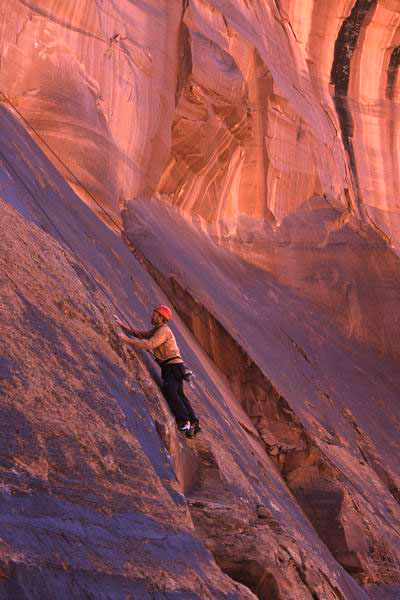

Next, my guide showed me how to place and remove camming devices. These
valuable and perhaps the most sophisticated pieces of all the climbing
gear are typically made up of four individual cams that are pushed into
a crack in the rock. A trigger system on the other side of the device
is released, and the cams open back up, securing into the crack. The trigger
is also used to contract and release the cams when the need arises.
With the instruction finished for the time being, Bigwood made the ascent
to the top, secured himself in, and shouted down, “You’re
on belay!” During this climb he was belaying me from the top in
the same manner we’d be using on the tower. After exchanging the
appropriate verbal responses, I began scaling the wall.
The techniques I learned came in handy. I found myself negotiating the
crack with relative ease, kicking the toes of my climbing shoes into the
cracks on either side of the main rift, using the hand jams, and even
stopping to remove the camming devices—another skill I’d need
on the tower—before continuing upward.
At the top of the corner crack, Bigwood helped me set up for the final
technique I’d learn that day—repelling. We would use the belay
device in a similar fashion to belaying, only without assistance, and
each of us would control our own descents. Bigwood went first, leaning
back into his harness like it was a chair. He jumped backward, flew through
the air, made contact with the wall, and then repeated the maneuver a
couple times before reaching the ground.
When it was my turn, I leaned back over the edge of the cliff, allowing
my body to sink into the harness, and then slowly walked backwards. Although
my descent was jerky from a lack of control over how the rope slid through
my hands, I did make it to the bottom without smacking any part of my
body on the wall. The overall feeling of accomplishment for a day of climbing
well done stayed with me long after we’d packed up and headed back
to Moab for the evening.
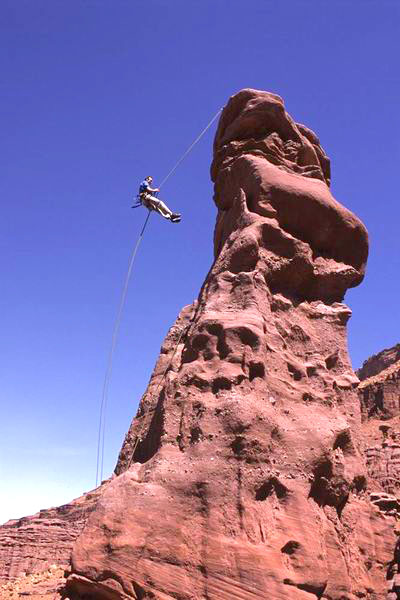

The following morning we set out early for the Ancient Art tower, heading
northeast into the desert, flanking the Colorado River. When we arrived
at the parking area, we could see Ancient Art in the distance, rising
up 550 feet from the desert floor. The
staggered tiers of its summit clearly displayed where the name was derived
from. Before we even hopped out of the Toyota, my apprehension—which
had been building since the night before—reached into the overload
range, and I could feel my heart pounding in my chest. I don’t think
I’m ready for this, I thought to myself as we began our hike towards
the tower.
Looking up to the top of Ancient Art from its base didn’t ease my
nerves any. The tower appeared big enough from the parking area, but from
where I was standing, it looked absolutely massive. Bigwood must have
noticed my fear because he had us climbing within minutes.
The first 50 feet of the tower was similar to the climbing I’d done
the previous day, but then it changed—the handholds and foot placements
seemed to disappear like a mirage in the desert, and the route became
extremely difficult. Shortly after that, it became impossible for me.
Luckily Bigwood had brought étriers (climbing ladders) and had
set one in place during his ascent exactly where my limited skills would
allow me to continue no further.
Directly above me Bigwood called down and instructed me to place my feet
into the rungs of the ladder and push upward. Despite hitting my knuckles
on the wall a few times, the ladder, along with the little notches that
kept the section of rock from being completely smooth, allowed me to finally
scramble to the ledge where Bigwood waited.
The next section we’d climb would force Bigwood and me to be separated
and out of each other’s sight for a long period of time. With my
apprehension at peak levels, I tried to listen to my guide’s final
instruction and then watched him climb until he disappeared around an
overhanging ledge 75 feet above my location.
Once Bigwood was secured in a lofty position150 feet above me, I heard
him call down that I was on belay. “Climbing!” I shouted back
and began my ascent. At first the climb was going okay; I used the techniques
from the day before—hand jams, kicking my shoes into cracks, trying
to control my breathing, looking around for handholds and foot placements,
and relaxing when things got tough.
Further along l found that despite all of Bigwood’s excellent instruction
and encouragement, the rock was beating me. My body ached, my fear built
with each inch of progress, and my hands and feet were slipping. Finally
I managed to scratch my way up to the overhanging ledge Bigwood had made
short work of during his climb. Looking around I couldn’t see anywhere
to place my hands or feet. The panic elevated to a level that I could
no longer bear. I felt completely encased in rock.
-Space-
As far as I can tell, there is absolutely no way for me to get around
and on top of the ledge. Defeated, I shout up at Bigwood, “I’ve
got to go down!” He wants to know if I’m sure, and I shout
back that I am. Bigwood then lowers me to where I can later safely repel
and says that he will be down as soon as the other climbers who are on
the tower today make their own repels.
After what seems like forever, the two climbers repel past me, and Bigwood
arrives at my position. I’m finally going to be able to make my
descent. The repel happens quickly as I lie back in the harness and allow
myself to float back to the safety of the desert floor. I’m the
last one off the tower, but that doesn’t matter to me, because in
my case, repelling is a much more enjoyable experience than climbing and
being back on the ground feels even better.
On the way back to the truck, Bigwood mentions that even he has to abandon
climbs from time to time because he has reached his limit. “That’s
how you improve at
rock climbing,” he says. “You keep doing climbs that are slightly
above your level until you can overcome them.”
By the time we get back to Moab, my bruised ego has slightly mended. Leaving
Utah in the distance the next morning, I vow that when I get home, I’ll
attempt climbing on the cliffs there….
On the sheer, vertical rock overlooking the valley I call home, I finally
manage to climb to the top of a fairly difficult route sans the overhanging
ledges.
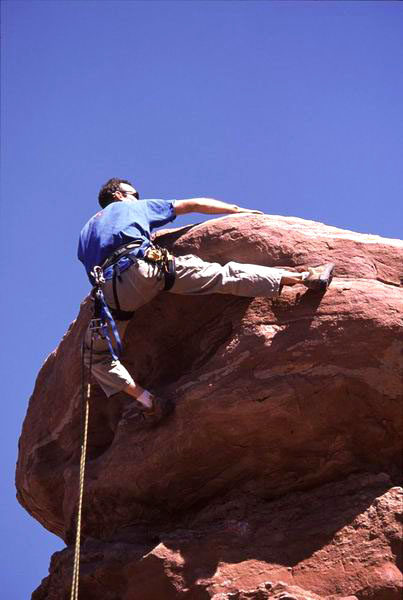
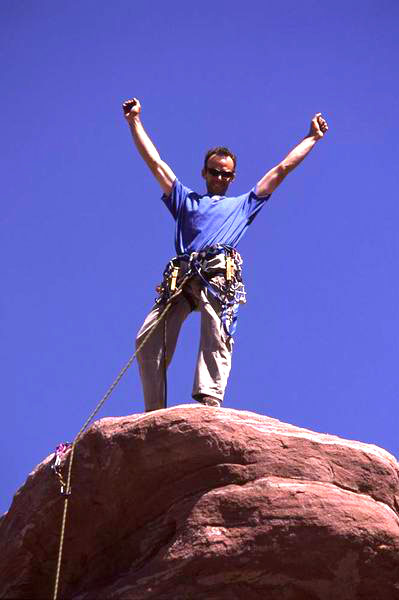
End
Photography: Phil Maranda
Tracey and I both got the chance to make images during the rock climbing
assignment which was a special treat for we don’t get the chance
to work together on big assignments very often—I usually have to
go those alone. Having two photographers doing the shooting also really
helped me out. It’s just one less thing to think about when you’re
convinced that the Reaper is looking over your shoulder, laughing manically
over the foolishness of your actions.
Besides the blazing sun, red dust, dry heat, and vertical environment
associated with climbing in the Moab area, the photography part of our
experience came off without a hitch. Improvisation was the key to shooting
in the desert: when we arrived at the first wall which happened to be
lying in shadow on a bright sunny day, we used a Tiffen 812 warming filter
to compensate; then as the sun broke over the ridge, we slapped a polarizer
on the lens to try and tone down the glare a little and bring out the
colors. When we discovered that I’d left the tripod mounting plate
for our Nikkor 80-400mm VR lens 1500 miles away, we used the tripod collar
on its own. Luckily we had a Kaiser ball head on our Gitzo carbon-fiber
tripod that allowed us to secure the lens by literally clamping the tripod
collar to the ball head where the mounting plate usually goes. It worked,
but it isn’t advisable.
Tracey Lalonde
For the distant shots of Ancient Art tower and the climbers, I found a
really great vantage point down in the desert on a giant rock not too
far from the base of the tower. There, I set up the Gitzo carbon-fibre
tripod and the Nikon F100 with Nikkor 80-400mm VR lens. As Phil and Noah
came into view, about a third of the way up, I was able to capture their
climb at various stages up the tower and also give a sense of environment,
at times including the entire tower in the shot. I could then show the
immense size of Ancient Art in relation to the climbers. This, I feel,
allows viewers to experience the scene from my vantage point but also
have an idea how the climbers themselves must have felt during the climb.
Because the climbing took place early in the day, I had some beautiful
morning light to work with. As it was spring, I didn’t have much
of a problem with strong sunlight (which I kept my back to) once the sun
was higher in the sky, but I did use a polarizer.
I also had an incredible spot with which to witness the event, and I could
use the telephoto to keep track of where Phil and Noah were climbing—it
brought me close up to them, giving me a sense of being right there each
step of the way (and it had me thanking God I wasn’t actually doing
the climbing!).